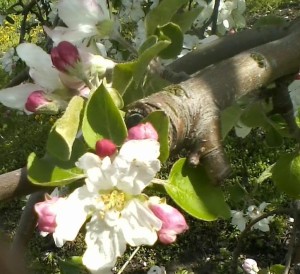The bloom in the apples was breathtaking! Cool temperatures allowed for an extended
bloom and a longer pollination period. The severe winter affected the honey bees in our orchard. Eighty percent of the hives did not survive the winter thus creating a need to purchase bees from outside sources. We had always toyed with the idea to experiment with bumble bees and the need to find other “pollinators” this year made our decision rather easy. We purchased several hives and placed them in the apple orchard. From the first day onward, these creatures worked incessantly. Bumble bees work under more adverse weather conditions than honey bees and we were pleasantly surprised at their work habits. Overall, this experiment with bumble bees had “fruitful” results.
Now, it is time for the agonizing decisions of thinning the varieties that are heavy in fruit set. Thinning is done to reduce the harvest. Without it, there would be too much fruit on each tree, affecting the size of the apples. The thinning process also helps the tree by eliminating stress to it if the tree is heavily laden. Miscalculations in the use of thinning chemicals could actually wipe out an apple crop. Too much is never good in the applications of thinners. Upon examination some varieties this year look good as they are, while others have too much fruit set.
We had no blooms in the peach orchard. Absolutely, none. Purdue University reports a major loss in peach production throughout the state of Indiana and in our neighboring states as well.
Mowing and weed control are underway in the orchards. It’s a good thing that I like to use the mower and weed eater because both the grasses and the weeds are experiencing tremendous growth. We make good efforts to eliminate overuse of herbicides in our orchards but in so doing, we have to use more labor intensive methods of control.

